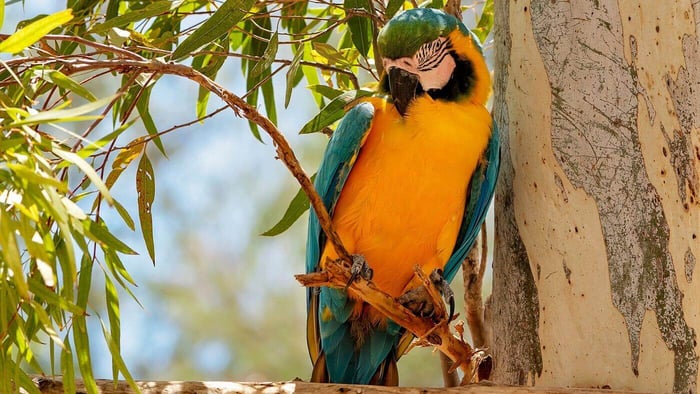Bringing home a Blue and Gold Macaw Parrot is a joyful experience, especially for pet lovers seeking a colorful, intelligent companion. These parrots are known for their striking blue and yellow feathers, playful personalities, and strong bonds with their human caregivers. However, if you already have other pets at home—like cats, dogs, or smaller birds—it’s important to carefully introduce your new Macaw to prevent stress, injury, or behavioral problems.
In this guide, we’ll cover the essential steps on how to introduce your Blue and Gold Macaw Parrot to other pets at home in a safe and effective way, focusing on gradual socialization and proper care.
Why a Safe Environment Is Crucial
When it comes to Blue and Gold Macaw Parrot care, setting up a safe environment is the first and most important step. Macaws are large, powerful birds, and they can be unpredictable if startled. Designate a quiet, neutral space where neither your Macaw nor your other pets feel territorial. The area should be free of small objects that could be swallowed and should have enough space for your parrot’s cage. Blue and gold macaw pet introduction
A well-prepared space gives both your Macaw and your other pets a sense of security. It prevents sudden confrontations and creates a positive foundation for interaction.
Start with Scent and Sound Familiarization
One of the most effective ways to introduce a Blue and Gold Macaw Parrot to dogs and cats is through scent and sound familiarization before a face-to-face encounter. Allow your cat or dog to sniff a toy or perch that belongs to your Macaw, and let your Macaw hear recordings of dog barks or cat meows at a low volume. This helps both sides become comfortable with the presence of the other.
Using this method reduces fear and prevents overstimulation during direct introductions. It’s a gentle way to prepare all pets without overwhelming them.
Gradual Visual Introductions
Once the pets seem comfortable with scents and sounds, the next step is a controlled visual introduction. Place your Blue and Gold Macaw Parrot in its cage in a central part of the room and allow your other pets to calmly observe from a distance. Watch their body language carefully:
- The Macaw may cock its head and observe curiously.
- The dog may sit or sniff calmly, while the cat may stare without sudden movements.
Repeat this visual exposure in multiple short sessions over several days until all pets show signs of relaxed interest without aggression or fear.
Supervised Interaction and Positive Reinforcement
When both the Macaw and your other pets appear calm, you can proceed with supervised interaction outside the cage. Keep your dog on a leash and ensure your cat is under control. Gently allow your Macaw to perch nearby while rewarding positive behavior with treats and praise.
Positive reinforcement plays a key role in training a Blue and Gold Macaw Parrot to coexist with other pets. Consistently rewarding calm, non-aggressive behavior helps build trust. Be patient—each pet adjusts at their own pace, and rushing this process can cause setbacks. Blue and gold macaw pet introduction
Monitor for Stress and Health Concerns
Proper Macaw stress management is essential throughout the introduction. Watch for signs of stress such as feather plucking, loud screaming, or hiding. Likewise, monitor your dog or cat for signs of unease or aggression, like growling or hissing.
Regular veterinary check-ups for your Blue and Gold Macaw Parrot are important, especially during this transition period. A healthy Macaw is more likely to handle new experiences confidently, while early detection of health issues prevents future complications.
Final Thoughts
Successfully introducing a Blue and Gold Macaw Parrot to other pets is a process that requires patience, careful planning, and ongoing observation. By creating a safe environment, using scent and sound familiarization, conducting gradual visual and supervised interactions, and consistently monitoring stress signs, you help your Macaw develop positive relationships with your other pets.
With proper care and gentle guidance, your Blue and Gold Macaw Parrot will thrive as a beloved, well-socialized member of your multi-pet household. Investing time in this process ensures a happy, healthy life for your colorful, playful companion.

